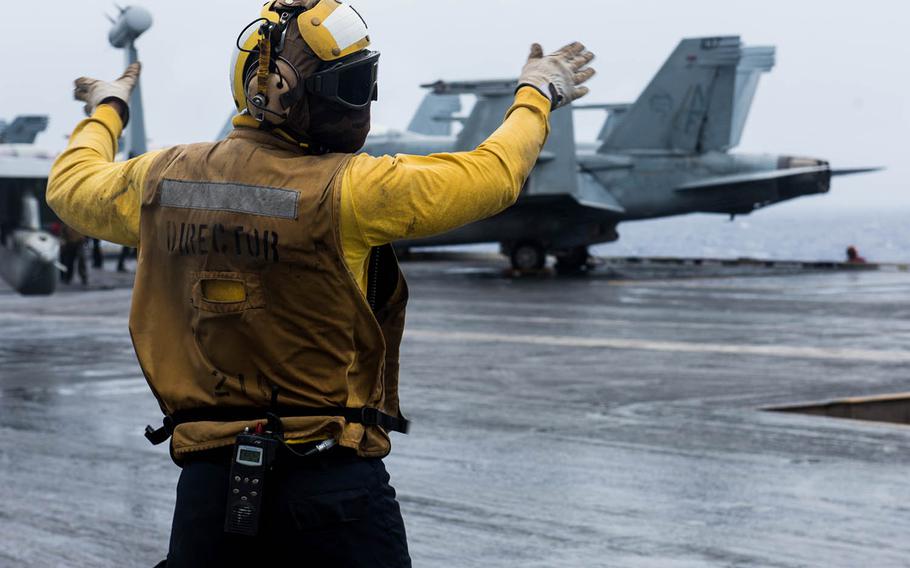
An aviation boatswain's mate directs an aircraft on the flight deck of the aircraft carrier USS Ronald Reagan in the Philippine Sea, Sept. 20, 2018. (Kenneth Abbate/U.S. Navy photo)
YOKOSUKA NAVAL BASE, Japan — Navy ship crews in Japan have seen a drastic improvement in training certification numbers, but some sailors report no change to heavy workloads cited last year as a contributing factor in two deadly ship collisions, according to a Government Accountability Office report.
The report, published last month, said the Navy in Japan had “improved markedly” the number of surface ship crews with lapsed training certifications over the past year.
In September 2017, about 41 percent of guided-missile cruisers and destroyers based in Japan were operating despite expired certifications. As of November, that number was down to 3 percent.
These certifications are given in crucial areas such as damage control, surface warfare and navigation once crews complete required trainings and meet qualifications for their rates. They signify that a ship’s crew has met Navy standards and is ready to deploy.
After three ships based in Japan were involved in collisions last year — two of which killed a total of 17 sailors — the Navy made it more difficult to issue waivers to allow ships to operate on lapsed training certifications. A new policy requires multiple, high-level officials to approve a waiver.
The waiver change was among several other changes — including revised sleeping schedules and improved training and standards — implemented over the past year to prevent future crashes. Post-collision reports attributed inadequate training and lack of sleep for crews as contributing factors in the fatal wrecks, which experts said were preventable.
John Pendleton, director of Defense Capabilities and Management for the GAO, testified at a congressional hearing on Navy and Marine Corps readiness last week about his findings from a recent visit to Japan. He attributed the improvement from the “alarming rate” of waivers to the implementation of the Afloat Training Group Western Pacific.
“The Navy has [increased certification numbers] by pouring resources into what’s called the Afloat Training Group, and that means that folks are going out and working with the ship crews to make sure that they’re trained and certified before they deploy,” Pendleton said at the hearing.
The ATGWP oversees maintenance, training and certification for the Navy’s ships in the Pacific. It was launched this year in Yokosuka to have an on-site team dedicated to working closely with ship commanders to ensure ship and crew standards are met.
While the renewed emphasis on training addressed one causal factor identified in the collision reports, Pendleton said it did little to improve another factor: sailor exhaustion.
“The Navy has stepped up training to make sure that ship crews are [trained] before they [deploy] and they have committed to provide dedicated training time going forward,” he told Congress. “However, this is keeping the sailors very busy.”
Pendleton testified that he held 10 discussion sessions with sailors on two Yokosuka-based ships during which many reported heavy workloads and 100-hour work weeks.
“I’m concerned that this reveals an underlying problem still facing the Navy — that it simply is not putting enough sailors on the ships to cover the workload,” Pendleton said at the hearing. “We reported on this last year; the Navy is working to develop ship-manning requirements both at-sea and in-port and we eagerly await the results to those studies as I suspect a number of hardworking sailors do, as well.”
But change could come, as the average sailor’s workload is under examination. Congress required the Navy in the 2018 National Defense Authorization Act to work on “a comprehensive assessment” of its standard workweek and to update its “policies and procedures necessary to identify the manpower necessary to execute in-port workload,” Sen. Roger Wicker, R-Miss., said at the hearing.
The assessment and updates are due to Congress in February, and Secretary of the Navy Richard Spencer testified at the hearing that the deadline will be met.